b9cb1fcbf7f1756abc478d9c5b23ea13.ppt
- Количество слайдов: 123

PROJECT MANAGEMENT Achieving Problem Free Project Management Dr. Marian Krupa

Dr. Marian Krupa e-mail: mkr 4 all@gmail. com www. mgmt 4 all. com

AGENDA 1. Management by projects (MBP) 2. The dynamic project plan (DPP) 3. Defining the project objectives and tasks 4. Scheduling for being on time 5. Budgeting and controlling the cost 6. Enhancements to the dynamic project plan 7. Resources and motivation 8. Reports, Actions, and Solutions 9. Motivation 10. The project manager’s special authority 11. Computer assistance – IT and PM 12. Managing time

EXAM Design and present one of the selected project listed below: 1. The International Conference Project – Gantt Chart (MS Excel, Visio, other) 2. The International Conference Project – PERT (MS Project, Visio, other) 3. The International Conference Project – LOB (MS Excel, Visio, other)

1. Management by projects (MBP)

PROJECT MANAGEMENT - definitions Project: ü a temporary and one-time endeavor undertaken to create a unique product or service, that brings either beneficial change or added value. ü a carefully defined set of activities that use resources (money, people, materials, energy, space, provisions, communication, quality, risk, etc. ) to meet the pre-defined objectives. http: //en. wikipedia. org/wiki/Project ü a temporary endeavor undertaken to create a unique product or service A Guide to the Project Management Body of Knowledge (PMBOK® Guide), Third Edition, Project Management Institute.

PROJECT MANAGEMENT - definitions Management: ü Coordinating work activities so that they are completed efficiently and effectively with and through other people. Efficiency – keeping costs down. Effectivness – achieving objectives. Efficiency is „doing things right”. Effectivness is „doing the right things”. Robbins, Coulter, Management, Pearson/Prentice Hall, USA 2005, p. 7. Robbins, Coulter, Management, Pearson/Prentice

PROJECT MANAGEMENT - definitions Management: ü Wealth creating activity. ü The art of using human and material resources to produce and market (sell) goods and services (customers’ needs). Archer, An Introduction to Canadian Business, Mc. Graaw-Hill Ryerson Ltd, Canada 1982, p. 450. Archer, Ltd,

PROJECT MANAGEMENT - definitions Management: ü ü ü ü All about decisions Risk taking Objectives Problem solving Asking right questions Satisfying people Planning, organizing, directing & controlling Robbins, Coulter, Management, Pearson/Prentice Hall, USA 2005, p. 9. Robbins, Coulter, Management, Pearson/Prentice

PROJECT MANAGEMENT - definitions Project Management (PM) / Management by Project (MBP): ü the discipline of organizing and managing resources in such a way that these resources deliver all the work required to complete a project within defined scope, quality, time and cost (budget) constraints. ü management activity that requires much more detail in planning and control than general management does. ü PM covers key business processes, strategic customers, markets, products, divisions etc. http: //en. wikipedia. org/wiki/Project

PROJECT MANAGEMENT - definitions Project Management (PM) / (MBP): ü Project management is no small task. ü Project management has a definite beginning and end. It is not a continuous process. ü Project management uses various measurement tools to accomplish and track project tasks. These include Gantt and Pert charts. ü Projects frequently need resources on an add-on basis as opposed to organizations who have full-time positions. www. snc. edu

PROJECT MANAGEMENT - definitions General Management Project Management /MBP

PROJECT MANAGEMENT - definitions High Management by PROJECT PM PM means & tools implementat ion Craftsmanship GM Low High Standardization / Continuity

2. Project Management Triangle

PROJECT MANAGEMENT - definitions Project Management Triangle: ü It is a management processes of planning, implementing and controlling of any one-time human activity within time, budget and scope boundaries, to deliver high quality at low absorption level of resources. time scope budget

PROJECT MANAGEMENT - definitions Project Management Triangle: time (schedule) Objective(s) budge t (cost) quality Scope (tasks)

PROJECT MANAGEMENT - definitions TIME: ü the time required for each task is estimated. ü It is important to divide the work into several smaller pieces so that it is easy to measure progress. ü A Work Breakdown Structure (WBS) is commonly used to develop the list of tasks each of which is then given a time estimate. ü Time is not considered a cost nor a resource since the project manager cannot control the rate at which it is expended. This makes it different from all other resources and cost categories. http: //en. wikipedia. org/wiki/Project

PROJECT MANAGEMENT - definitions SCOPE: ü Requirements specified for the end result. ü The overall definition of what the project is supposed to accomplish, and a specific description of what the end result should be or accomplish. ü A major component of scope is the quality of the final product. ü The amount of time put into individual tasks determines the overall quality of the project. ü Over the course of a large project, quality can have a significant impact on time and cost (or vice versa). http: //en. wikipedia. org/wiki/Project

PROJECT MANAGEMENT - definitions COST: ü Cost to develop a project depends on several variables including (chiefly): labor rates, material rates, risk management, plant (buildings, machines, etc. ), equipment, and profit. ü When hiring an independent consultant for a project, cost will typically be determined by the consultant's or firm's. http: //en. wikipedia. org/wiki/Project

PROJECT MANAGEMENT - definitions Project Management Triangle: üTo increase the scope of the project it is necessary to increase time and budget. üTo increase the level of quality it is necessary to absorb more resources.

PROJECT MANAGEMENT - definitions Project Management: Quality vs Resources: Efficiency of the project: Quality MAX Resources ? MIN

3. Methods and techniques of PM/MBP

Methods and techniques - definitions Method vs Technique: METHOD: a particular way of doing sth: a reliable / effective / scientific method of data analysis. - A new way of solving the problem - The best solution for arriving at an accurate prediction of the costs. Oxford Advanced Genie

Methods and techniques - definitions Method vs Technique: TECHNIQUE: a particular way of doing sth, especially one in which you have to learn special skills. Oxford Advanced Genie

Methods and techniques - definitions Method vs Technique: PRINCIPLE: ü a moral rule or a strong belief that influences your actions; ü a belief that is accepted as a reason for acting or thinking in a particular way; ü a general or scientific law that explains how sth works or why sth happens. Oxford Advanced Genie

Methods and techniques - definitions Method vs Technique: METHODOLOGY: a set of methods (techniques) used to perform a particular activity. SCIENTIFIC METHOD: a codified series of steps taken to complete a certain task or to reach a certain objective, see also algorithm, methodology. Oxford Advanced Genie

Methods and techniques - definitions Method vs Technique: ü Means – the way that any given problem can be solved – concept implemetation – e. g. a table, graph. ü Tools – physical thing that implements the mean – e. g. a paper, pencil, computer, software, calculator.

Project 1: Charts analysis 1 Project Management Triangle

Project 1: Charts analysis - LOB Tasks: ü 1. Accordingly to presented data evaluate the project performance. What are positives and negatives? ü 2. Present graphically your report by using the mean in any form of chart which is the most appropriate. You are allowed to select any tool.

Project 1: Charts analysis Answer 1: Evaluate the project performance. What are positives and negatives?

Project 1: Charts analysis Answer 2: Present graphically your report in any form of chart which is the most appropriate. You are allowed to select any tool.

Project 1: Charts analysis Line of Balance (LOB): ü Line of balance (LOB) was devised by George E. Fouch during the 1940’s to monitor production at the Goodyear Tire & Rubber Company. ü The line-of-balance (LOB) technique is a linear scheduling method that allows the balancing of the operations such that each activity is continuously and efficiently performed in each consecutive unit. ü A graphical display of scheduled units versus actual units over a given set of critical schedule control points on a particular day. The line of balance technique is oriented towards the control of production activities. www. 4 pm. pl www. iit. edu www. stsc. hill. af

Project 1: Charts analysis Line of Balance (LOB): ü It allows project managers to see, in the middle of a project, whether they can meet the schedule if they continue working as they have been. ü It exposes process bottlenecks, allowing the project manager to focus on those points responsible for slippage. www. stsc. hill. af

4. Charts and Graphs – means as concept implementation

Methods and techniques - definitions Method vs Technique: ü Means – the way that any given problem can be solved – concept implemetation – e. g. a table, graph. ü Tools – physical thing that implements the mean – e. g. a paper, pencil, computer, software, calculator.

Charts and Graphs Definitions: ü A chart or graph is a type of information graphic medium of communication (MK). ü Graphic organizer that represents tabular numeric data and/or functions. ü Charts are used to make it easier to understand large quantities of data and the relationship between different parts of the data. ü Charts can usually be read more quickly than the raw data. http: //en. wikipedia. org/wiki/Project ü They are used in a wide variety of fields, and can be

Charts and Graphs Example: By using progressive charts and key performance indicators PM manager visually improve the communication of your enterprise data www. bcdsoftware. com

Charts and Graphs Types of charts - Common charts: ü A line chart is a two-dimensional scatterplot of ordered observations where the observations are connected following their order. ü A bar chart uses bars to show frequencies or values for different categories. ü A histogram typically shows the quantity of points that fall within various numeric ranges (or bins). ü A pie chart shows percentage values as a slice of a pie. ü A scatterplot uses Cartesian coordinates to show the http: //en. wikipedia. org/wiki relation of two or more quantitative variables.

Charts and Graphs Types of charts - other charts: ü A box plot shows information about the distribution (minimum, maximum, mean average, etc. ) along a single axis. ü A Polar area diagram (developed by Florence Nightingale) is an enhanced form of pie chart. ü A bubble chart is a two-dimensional scatterplot where a third variable is represented by the size of the points. ü A radar chart (or "spider chart") is two-dimensional chart of three or more quantitative variables represented on axes starting from the same point. http: //en. wikipedia. org/wiki

Charts and Graphs Types of charts - other charts: ü A waterfall chart is a special type of floating-column chart. ü A Doughnut chart ü A ternary plot. http: //en. wikipedia. org/wiki

Charts and Graphs Example: Image is essential www. dotnetcharting. com

Charts and Graphs Chart types: Combo www. dotnetcharting. com

Charts and Graphs Chart types: Combo Side. By Side www. dotnetcharting. com

Charts and Graphs Chart types: Radar www. dotnetcharting. com

Charts and Graphs Chart types: Image Bars www. dotnetcharting. com

5. GANTT Charts Methods and techniques of MBP

GANTT Charts Background: ü The first Gantt Chart was actually developed by Karol Adamiecki, under the name Harmonogram. ü As Adamiecki did not publish his chart until 1931, this famous chart bears Gantt's name. ü Henry Gantt (1861 -1919) designed his chart in 1910 (see "Work, Wages and Profit" by H. L. Gantt, published by The Engineering Magazine, NY, 1910). http: //en. wikipedia. org

GANTT Charts Definition: ü A Gantt chart is a popular type of bar chart that illustrates a project schedule. ü Gantt charts illustrate the start and finish dates of the terminal elements and summary elements of a project. ü Terminal elements and summary elements comprise the work breakdown structure (WBS) of the project. ü The 100% Rule states that the WBS includes 100% of the work defined by the project scope and captures ALL http: //en. wikipedia. org deliverables (objectives).

Break Down Structure (WBS) Introduction: WBS of the project X Tasks of the project X T 1 T 2 T 3 T 4 T 6 T 5 T 6 T 7 T 8 T 9 T 5

GANTT Charts Introduction – Gantt chart structure: task T 1 T 2 T 3 T 4 T 5 T 6 T 7 T 8 T 9 day 1 day 2 day 3 day 4 day 5 day 6 day 7 day 8 day 9 day 10 day 11 time Task and its duration http: //en. wikipedia. org

GANTT Charts Introduction – Gantt chart structure: task T 1 T 2 T 3 T 4 T 5 T 6 T 7 T 8 T 9 day 1 day 2 day 3 day 4 day 5 day 6 day 7 day 8 day 9 day 10 day 11 time Phases, tasks groups: http: //en. wikipedia. org

GANTT Charts Introduction – Gantt chart structure: task T 1 T 2 T 3 T 4 T 5 T 6 T 7 T 8 T 9 day 1 Schedule dependences: day 2 day 3 day 4 „start-to-start”; „start-to-finish” „finish-to-finish” day 5 day 6 day 7 day 8 day 9 day 10 day 11 time http: //en. wikipedia. org

GANTT Charts Introduction – Gantt chart structure: 90% complete task T 1 100% complete T 2 90% T 3 80% T 4 T 5 0% T 6 T 7 T 8 T 9 day 1 day 2 day 3 day 4 day 5 day 6 day 7 day 8 day 9 day 10 day 11 time Project performance analysis http: //en. wikipedia. org

GANTT Charts Advantages and limitations: ü a common technique for representing the phases and activities of a project ü it usufull for projects with no more than about 30 activities ü Gantt charts only represent part of the triple constraints of projects, because they focus primarily on schedule (time) management ü do not represent the size of a project or the relative size of work elements – it represent their time duration. ü displaying a large number of dependencies may result in a cluttered or unreadable chart. http: //en. wikipedia. org

GANTT Charts and SAP R/3

GANTT Charts and SAP R/3

Project 2: Gantt Chart 2 The International Conference Project

Project 2: Gantt chart analysis Tasks: 1. Create a project plan for the International Conference – name, objective, activities, resources etc. 2. Present graphically your plan by using the Gantt chart.

Project 2: Gantt Chart Methodology: 1. Describe the name and the main objective of the project. 2. By using the 100% Rule define all activities that are necessary to perform the planned project (to achieve the stated goal/objective – step 1). 3. Put in an order (WBS) all defined activities/ tasks (step 2) – create phases of the project, function’s groups etc. 4. Define the start and finish date (time) of every given task. 5. By using the Gantt Chart present the plan of the project graphically. 6. Make all necessary descriptions.

Project 2: Gantt Chart Answer 1: MS Excel The „mile stone” for phase 1 is: the decision about the conference is made.

Project 2: Gantt Chart Answer 2 a: Power Point Tasks T 1 T 2 T 3 T 4 T 5 T 6 T 7 T 8 T 9 Calendar

GANTT Charts - examples Answer 2 b: VISIO

6. PERT - The Program Evaluation and Review Technique Methods and techniques of MBP

PERT Definition: ü The Program Evaluation and Review Technique (PERT) ü a technique (mean) that analyzes all tasks involved in completing a given project, ü especially to analyze the time needed to complete each task, and identifying the minimum time needed to complete the total project (the critical path). ü PERT was developed in the 1950’s, primarily to simplify the planning and scheduling of large and complex projects. http: //en. wikipedia. org

PERT Definition: ü An arrow-node diagram – a task network for a project made with arrows and small circles. ü A precedence diagram – a task network for a project made with boxes and realtionship lines. http: //en. wikipedia. org

PERT Nomenclature (key terms): event - end point that represents the completion of major activity The event number The latest possible finish time of the event The earliest possible start time of the event The slack time

PERT Nomenclature (key terms): Activity – time required to progress from one event to another Critical Activity – activity with zero slack time Links – neither time nor activity relationship

PERT Nomenclature (key terms): 0 2 0 0 0 4 3 5 ü events - end points that represent the completion of major activities ü activities - time or resources required to progress from one event to another ü slack time - amount of time an activity can be delayed without delaying the entire project ü critical path - the most time-consuming sequence of events and activities in a PERT network ü delays on critical path will delay completion of the entire project (zero slack time) © Prentice Hall, 2002
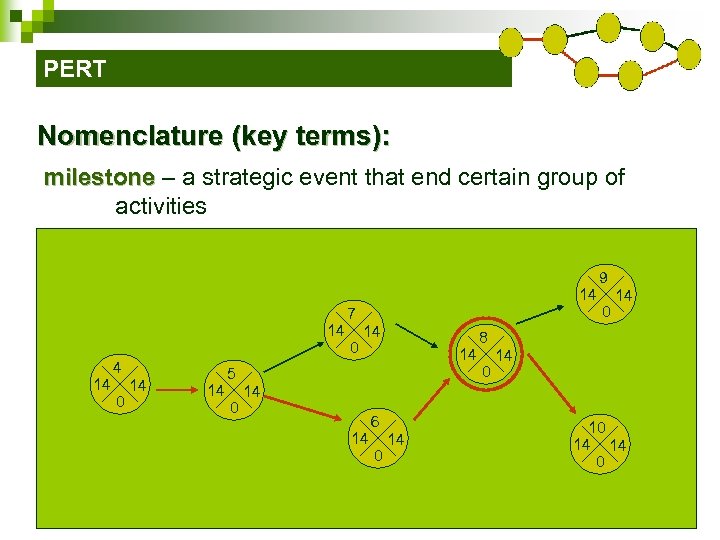
PERT Nomenclature (key terms): milestone – a strategic event that end certain group of activities 14 14 14 4 0 14 14 7 0 14 14 5 0 9 0 14 8 0 14 14 14 6 0 14 14 0

PERT - methodology Procedure „step-by-step”: Step 1: Create a table – activity / duration Step 2: Name events accordingly to the table Step 3: Link all the events with planned activities Step 4: Add duration time for each activity Step 5: Enter The earliest possible start time for every event Step 6: Enter the latest possible finish time for every event Step 7: Evaluate the slack time for every event Step 8: Underline (in red) the critical path of the entire project Step 9: Select milestones for the project

PERT - methodology Step 1: Create a table – activity / duration Activity: Duration: A. Activity a 2 B. Activity b 4 C. Activity c 4 D. Activity d 3 E. Activity e 5 F. Activity f 3 G. Activity g 2 H. Activity h 4 I. Activity i 2 J. Activity j 3

PERT - methodology Step 2: name events accordingly to the table 0 4 1 2 5 8 3 6 9 7 10
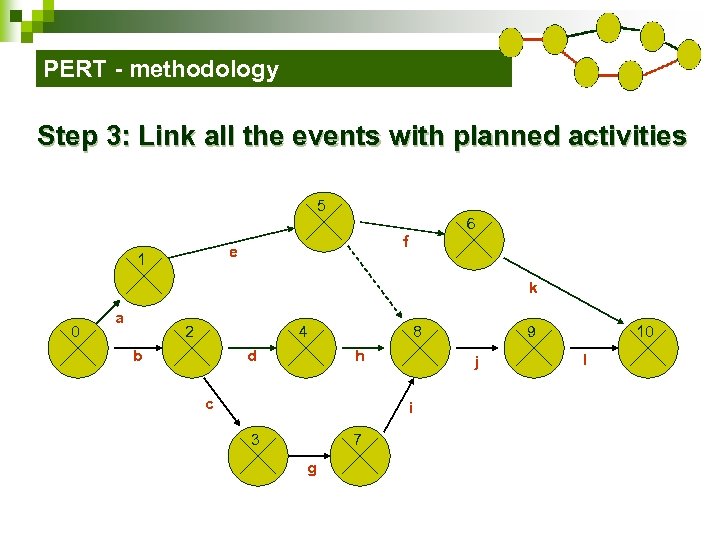
PERT - methodology Step 3: Link all the events with planned activities 5 6 f e 1 k 0 a 2 4 b d 8 h c j i 3 7 g 9 10 l

PERT - methodology Step 4: Add duration time for each activity 5 1 2 0 3 f 5 e 6 k a 4 b 2 3 d c 4 2 h 4 8 j 4 i 3 2 g 7 2 9 6 3 l 10
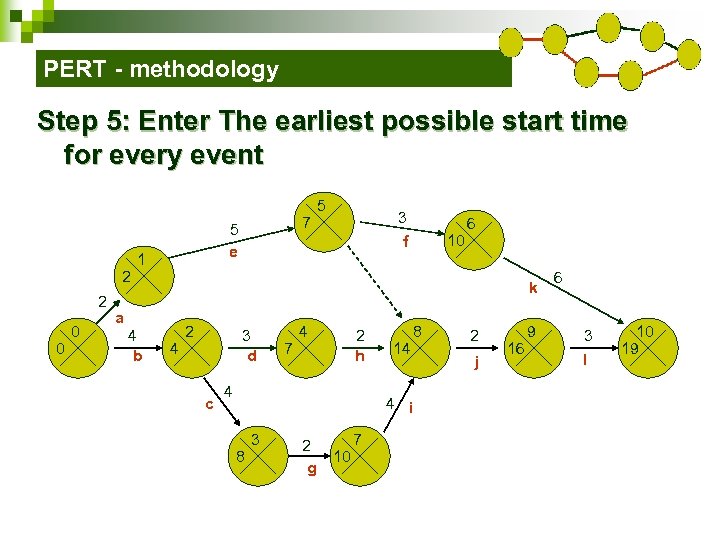
PERT - methodology Step 5: Enter The earliest possible start time for every event 2 2 0 0 1 3 f 10 6 k a 4 b 7 5 e 5 4 2 3 d c 7 4 2 h 4 14 8 4 i 8 3 2 g 10 7 2 j 16 9 6 3 l 10 19

PERT - methodology Step 6: Enter the latest possible finish time for every event 2 2 0 0 0 1 3 f 10 10 6 13 5 k a 4 b 7 5 e 5 4 2 3 d 4 c 7 4 2 h 12 4 14 8 4 i 8 3 8 2 g 10 7 10 14 2 j 16 6 9 16 3 l 10 19 19

PERT - methodology Step 7: Evaluate the slack time for every event 2 2 0 0 1 3 3 3 f 10 10 6 3 13 5 k a 4 b 7 5 e 5 4 2 0 3 d 4 c 7 4 5 2 h 12 4 14 8 4 i 8 3 0 8 2 g 10 7 0 10 0 14 2 j 16 6 9 0 16 3 l 10 19 19 0

PERT - methodology Step 8: Underline (in red) the critical path of the entire project 2 2 0 0 1 3 3 3 f 10 10 6 3 13 5 k a 4 b 7 5 e 5 4 2 0 3 d 4 c 7 4 5 2 h 12 4 14 8 4 i 8 2 3 0 8 g 10 7 0 10 0 2 14 j 16 6 9 0 16 3 l 10 19 19 0
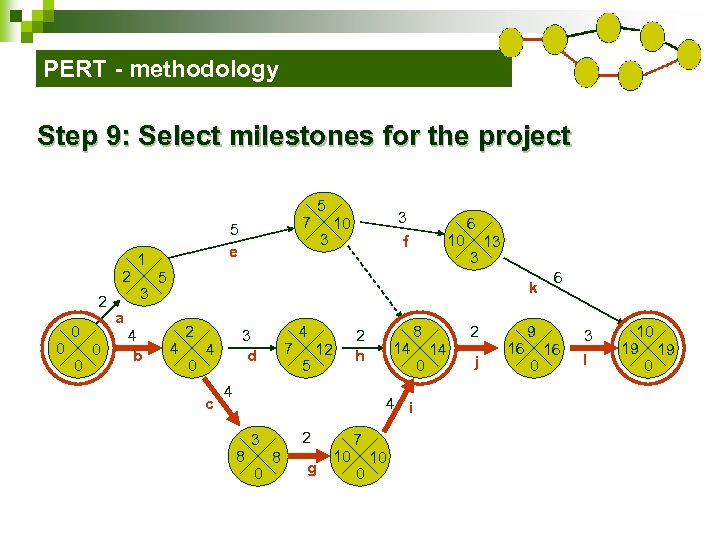
PERT - methodology Step 9: Select milestones for the project 2 2 0 0 1 3 3 3 f 10 10 6 3 13 5 k a 4 b 7 5 e 5 4 2 0 3 d 4 c 7 4 5 2 h 12 4 14 8 4 i 8 2 3 0 8 g 10 7 0 10 0 2 14 j 16 6 9 0 16 3 l 10 19 19 0

Project 3: PERT 3 The International Conference Project
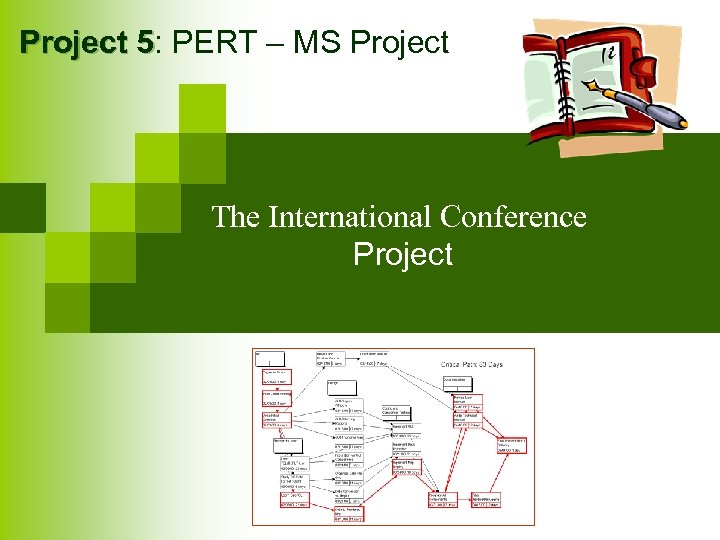
Project 5: PERT – MS Project 5 The International Conference Project

7. BEP – Break-even Point analysis Methods and techniques of MBP
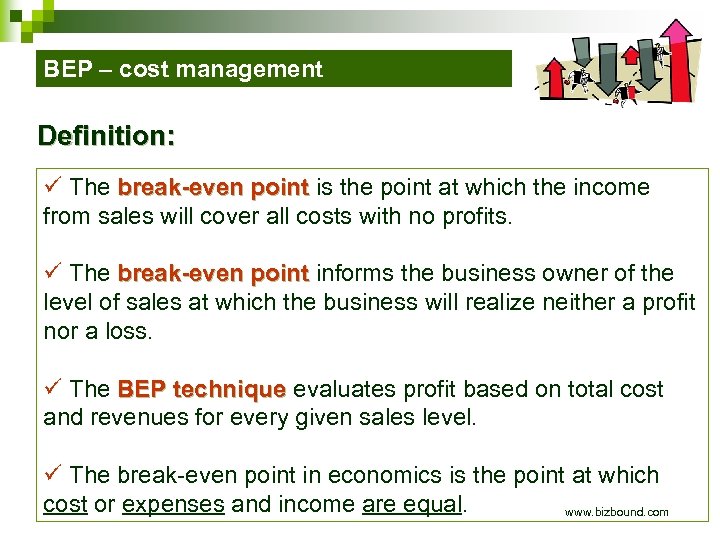
BEP – cost management Definition: ü The break-even point is the point at which the income from sales will cover all costs with no profits. ü The break-even point informs the business owner of the level of sales at which the business will realize neither a profit nor a loss. ü The BEP technique evaluates profit based on total cost and revenues for every given sales level. ü The break-even point in economics is the point at which cost or expenses and income are equal. www. bizbound. com

BEP – cost management Types of costs: ü The total fixed cost is the sum of all costs that do not change regardless of the level of sales. Rent and executive salaries are two examples. ü The total variable cost, on the other hand, is the sum of all cost the expenses that flucuate directly with the level of activity or sales. Cost of materials to produce a product or purchases of items for resale are two variable costs. www. bizbound. com
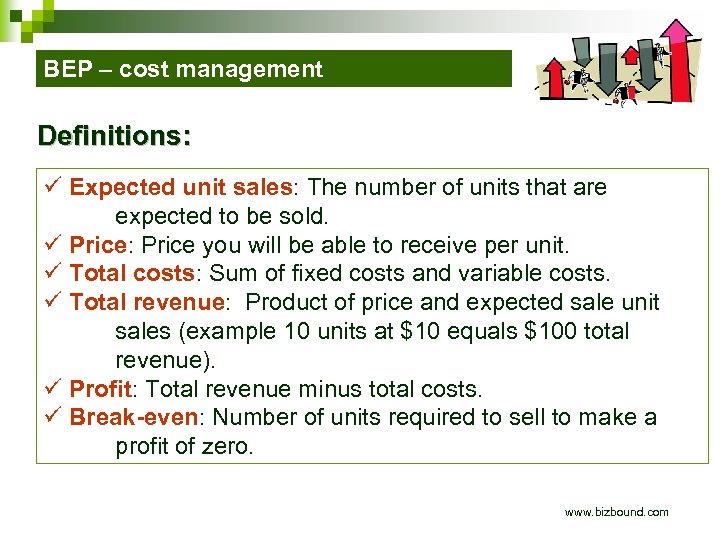
BEP – cost management Definitions: ü Expected unit sales: The number of units that are expected to be sold. ü Price: Price you will be able to receive per unit. ü Total costs: Sum of fixed costs and variable costs. ü Total revenue: Product of price and expected sale unit sales (example 10 units at $10 equals $100 total revenue). ü Profit: Total revenue minus total costs. ü Break-even: Number of units required to sell to make a profit of zero. www. bizbound. com
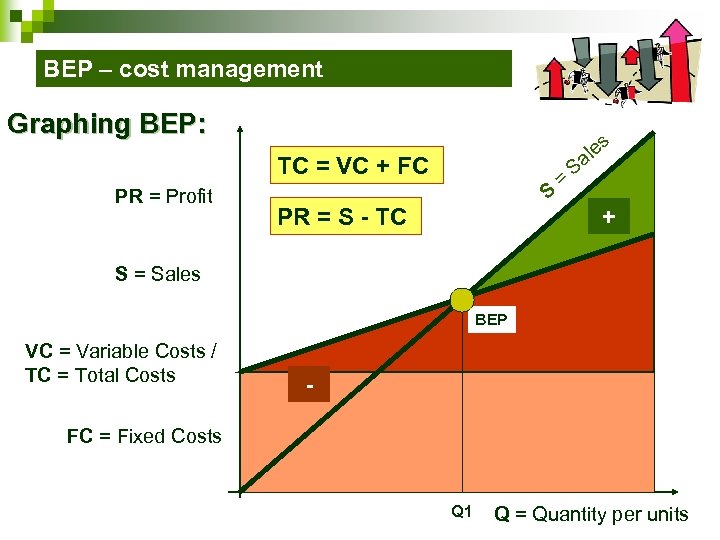
BEP – cost management Graphing BEP: s TC = VC + FC PR = Profit S PR = S - TC = e al S + S = Sales BEP VC = Variable Costs / TC = Total Costs - FC = Fixed Costs Q 1 Q = Quantity per units
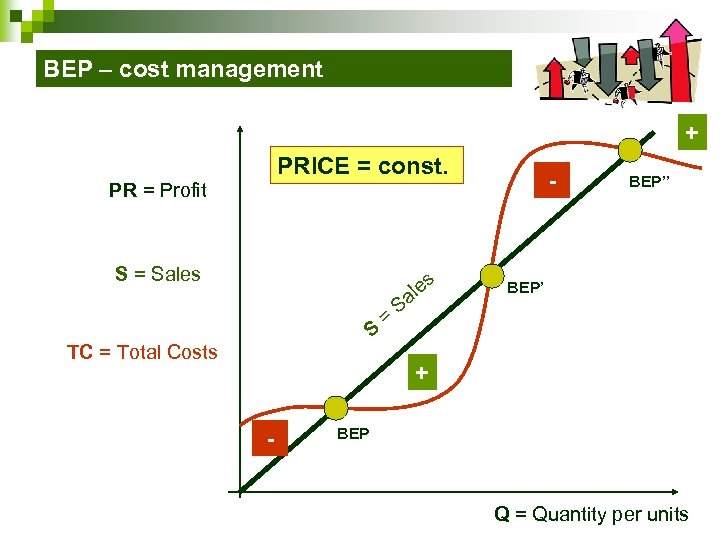
BEP – cost management + PRICE = const. - PR = Profit S = Sales s S TC = Total Costs = e al S BEP’’ BEP’ + - BEP Q = Quantity per units
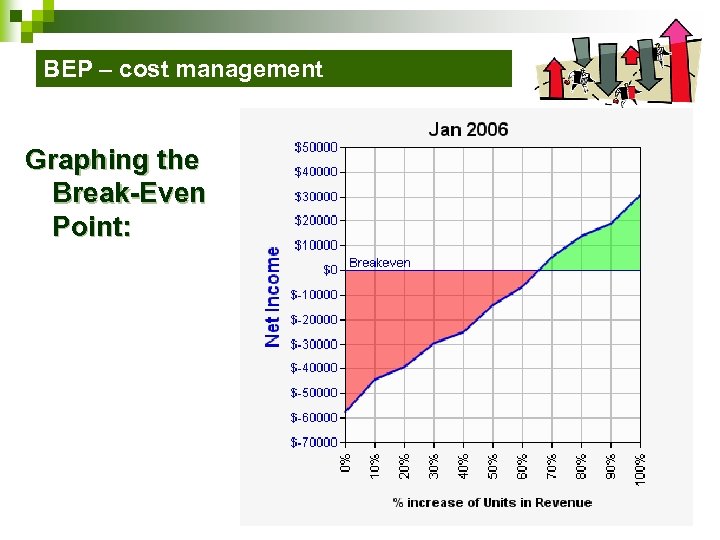
BEP – cost management Graphing the Break-Even Point:

BEP – cost management BEP general formula: Q = FC / (UP - VC) Q = Break-even Point, i. e. , Units of sale (Q), FC = Fixed Costs, VC = Variable Costs per Unit UP = Unit Price (UP > VC)
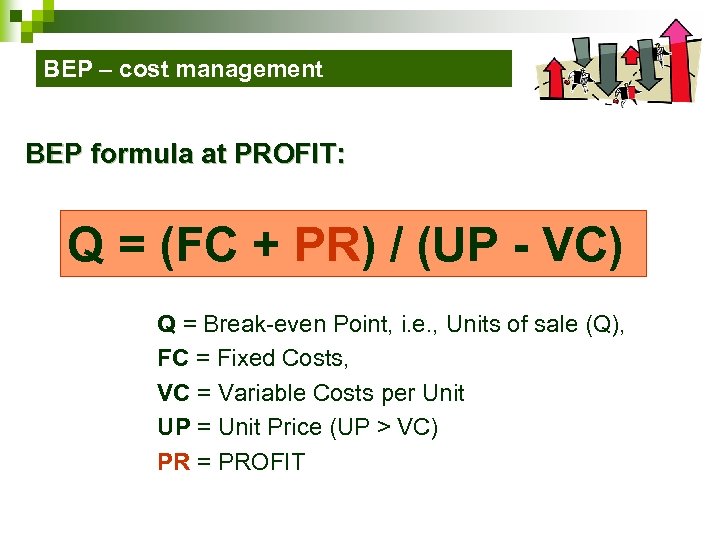
BEP – cost management BEP formula at PROFIT: Q = (FC + PR) / (UP - VC) Q = Break-even Point, i. e. , Units of sale (Q), FC = Fixed Costs, VC = Variable Costs per Unit UP = Unit Price (UP > VC) PR = PROFIT

Project 6: BEP analysis 6 The International Conference Project
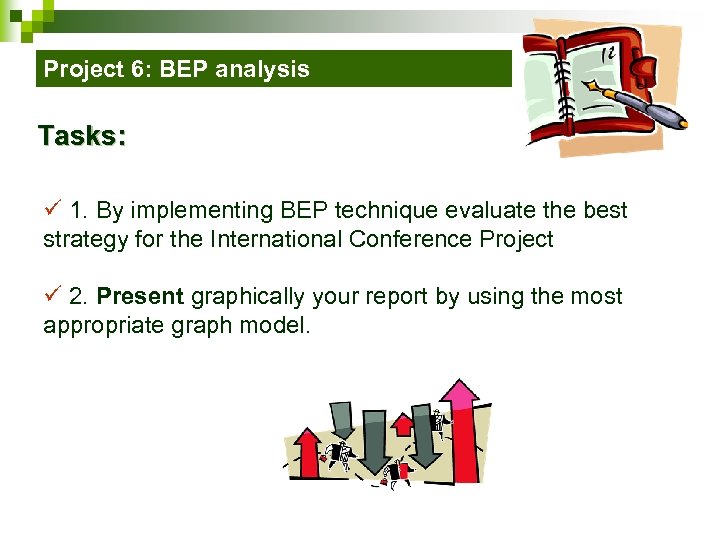
Project 6: BEP analysis Tasks: ü 1. By implementing BEP technique evaluate the best strategy for the International Conference Project ü 2. Present graphically your report by using the most appropriate graph model.
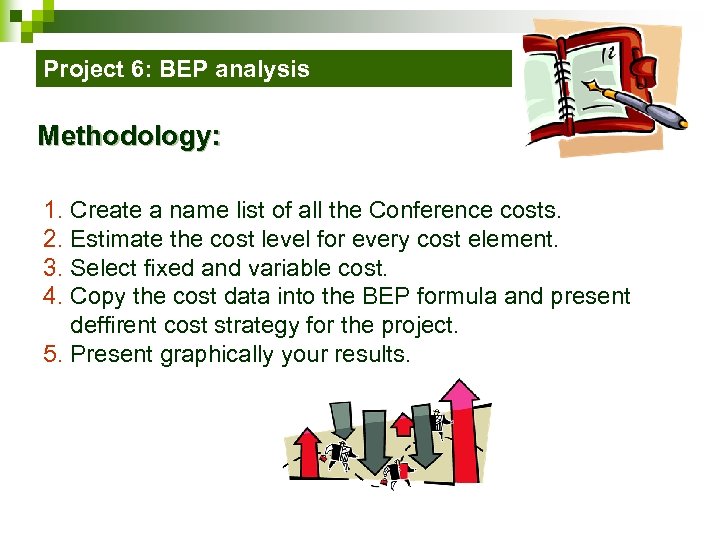
Project 6: BEP analysis Methodology: 1. Create a name list of all the Conference costs. 2. Estimate the cost level for every cost element. 3. Select fixed and variable cost. 4. Copy the cost data into the BEP formula and present deffirent cost strategy for the project. 5. Present graphically your results.
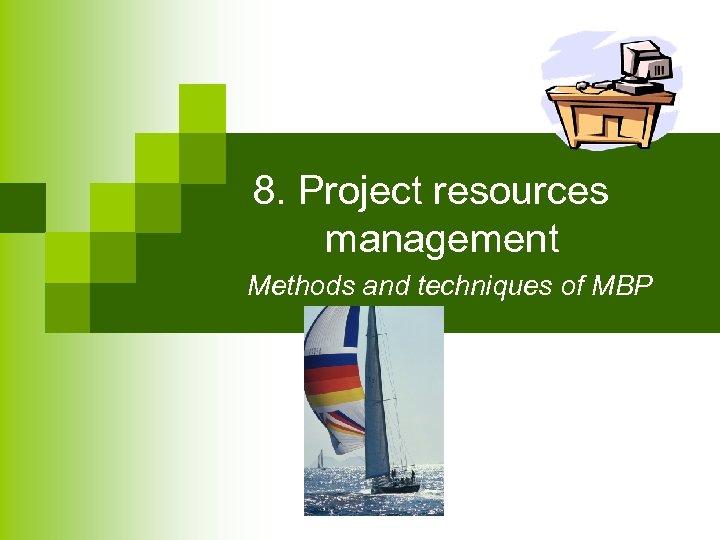
8. Project resources management Methods and techniques of MBP

Resource allocation and coordination What is PM ? Overview: ü Time management: Gantt charts, PERT ü Cost management: BEP, budgeting and cost calculation ü Task & event planning: 100% rule, WBS, MS Project ü Monitoring and control: LOB, Gantt, Pert (MS Project) ü Means and tools: software applications (MS Project, Excel) ü Resources allocation and coordination

Resource allocation and coordination Types of project resources: ü Human resources: by whom? ü Office infrustructure: where? ü Office equipment: what tools? ü Financial resources: how much and when? ü Information resources: how? why? what for? ü Time resources: how much time? ü Cultural resources: what ethical profile?

Project 7: ISO - Resources 7 allocation The International Conference Project

Project 7: ISO – resources allocation Introduction: ü Business Process Management by the ISO 9001: 2000 Standards. ü Main objective (mile stone) ü Input/ Output – resources / effects ü Task (functions) sequence list ü Participants ü Diagram ü Improvements !
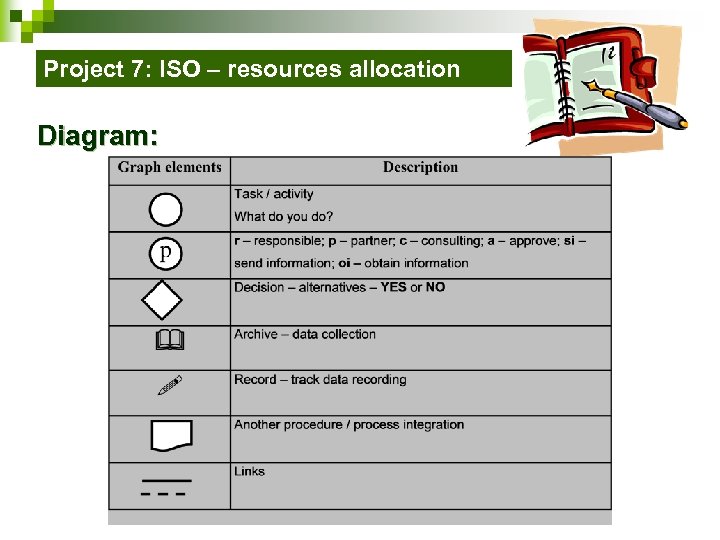
Project 7: ISO – resources allocation Diagram:

Project 7: ISO – resources allocation Example: How to apply for Polish visa in India?
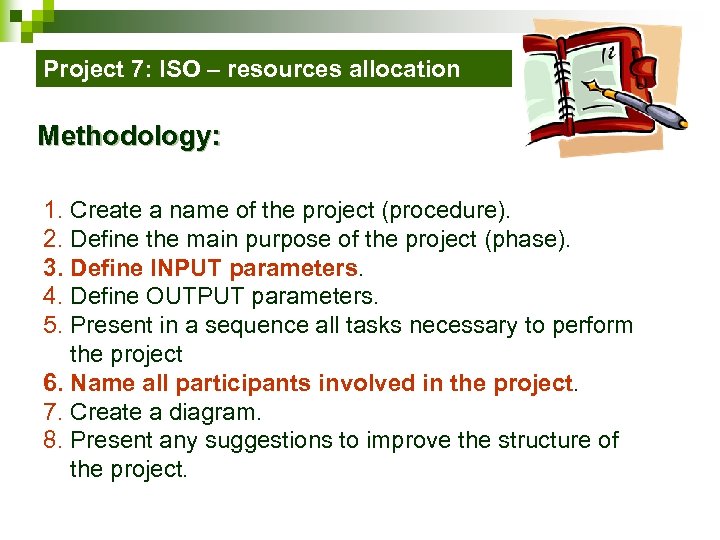
Project 7: ISO – resources allocation Methodology: 1. Create a name of the project (procedure). 2. Define the main purpose of the project (phase). 3. Define INPUT parameters. 4. Define OUTPUT parameters. 5. Present in a sequence all tasks necessary to perform the project 6. Name all participants involved in the project. 7. Create a diagram. 8. Present any suggestions to improve the structure of the project.
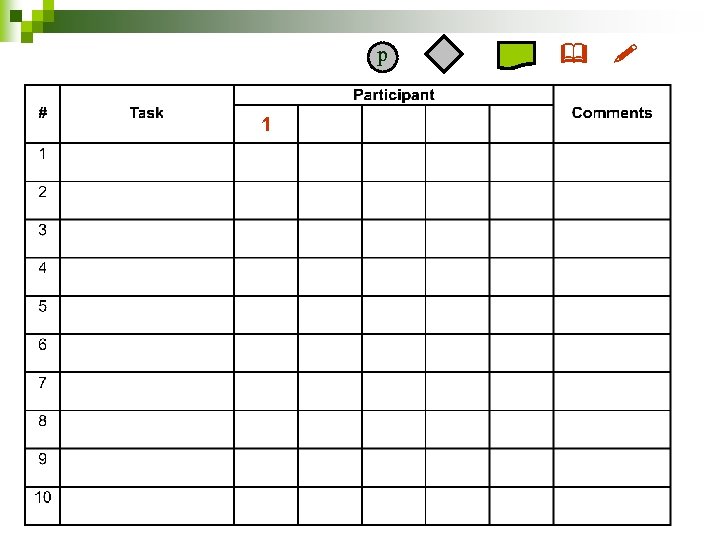
p 1
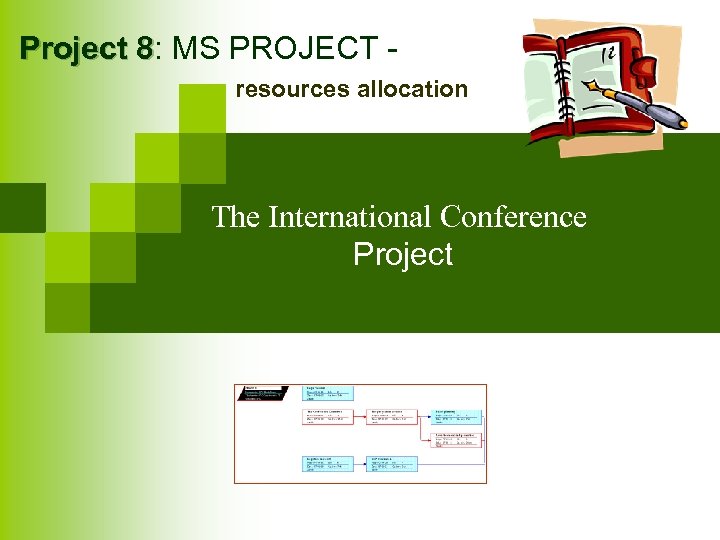
Project 8: MS PROJECT 8 resources allocation The International Conference Project

Project 8: MS Project Example:
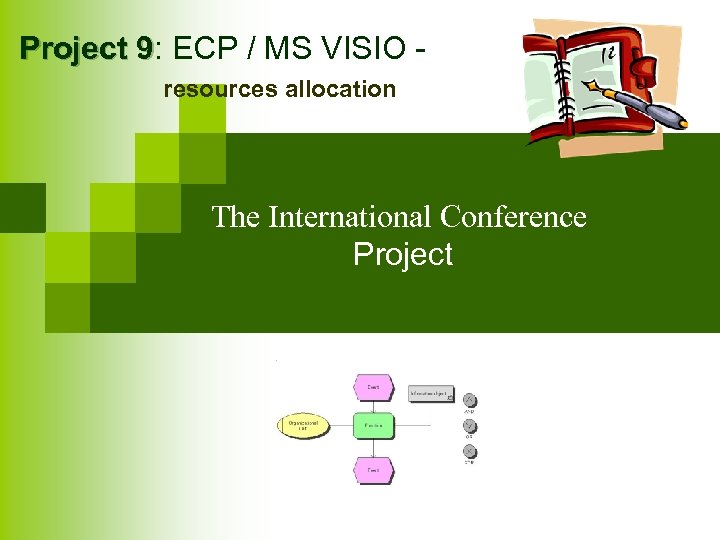
Project 9: ECP / MS VISIO 9 resources allocation The International Conference Project
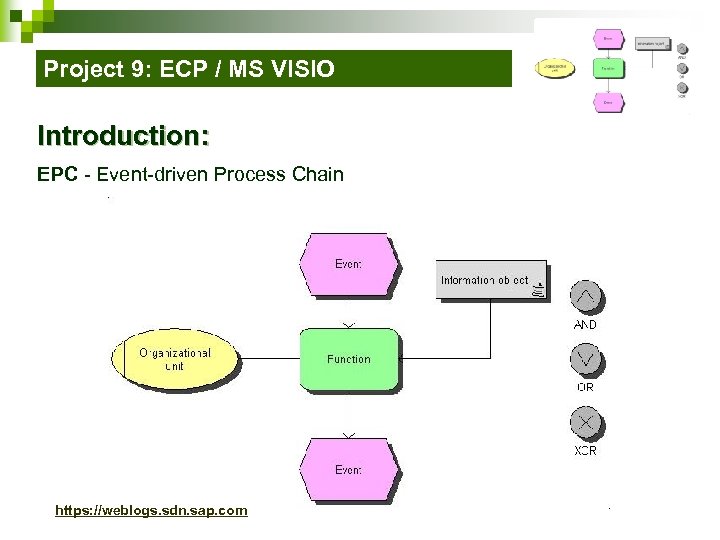
Project 9: ECP / MS VISIO Introduction: EPC - Event-driven Process Chain https: //weblogs. sdn. sap. com
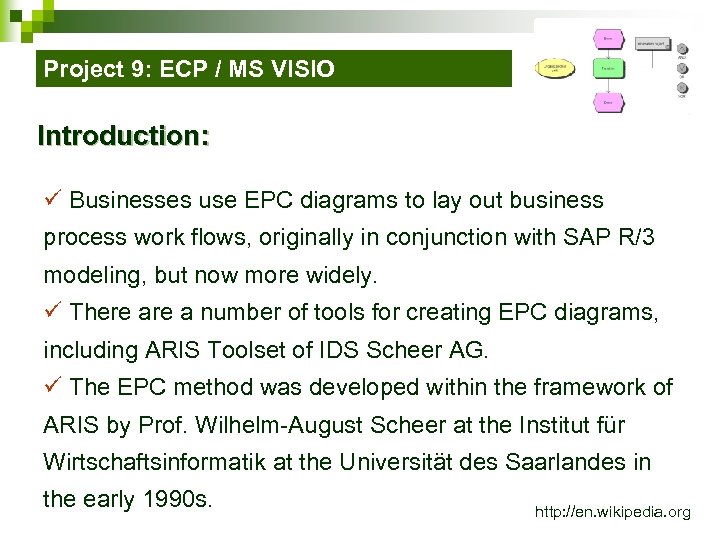
Project 9: ECP / MS VISIO Introduction: ü Businesses use EPC diagrams to lay out business process work flows, originally in conjunction with SAP R/3 modeling, but now more widely. ü There a number of tools for creating EPC diagrams, including ARIS Toolset of IDS Scheer AG. ü The EPC method was developed within the framework of ARIS by Prof. Wilhelm-August Scheer at the Institut für Wirtschaftsinformatik at the Universität des Saarlandes in the early 1990 s. http: //en. wikipedia. org

Project 9: ECP / MS VISIO Introduction: ü An EPC is an ordered graph of events and functions. ü It provides various connectors that allow alternative and parallel execution of processes. ü It is specified by the usages of logical operators, such as OR, AND, and XOR. ü A major strength of EPC is claimed to be its simplicity and easy-to-understand notation. This makes EPC a widely acceptable technique to denote business processes. http: //en. wikipedia. org

Project 9: ECP / MS VISIO Example: http: //en. wikipedia. org

Project 9: ECP / MS VISIO Introduction: EVENT FUNCTION ü EPC - Event-driven Process Chain ü EVENT – describes a change ü FUNCTION – describes an activity ü PARTICIPANT – defines who performs the function ü LOGIC operator – describes alternatives

Project 9: ECP / MS VISIO Introduction: EVENT ü EVENT – it is used to illustrate business relevant causes and effects of any given action (function). Every EPC starts and ends with an event. An event can trigger or be the result of a function. https: //weblogs. sdn. sap. com

Project 9: ECP / MS VISIO Introduction: FUNCTION ü FUNCTION – illustrates actions, operations or procedures which are business relevant. They are the connector between the Events and consume resources and time. ü Functions can be modeled linear, parallel or as alternative branches. https: //weblogs. sdn. sap. com
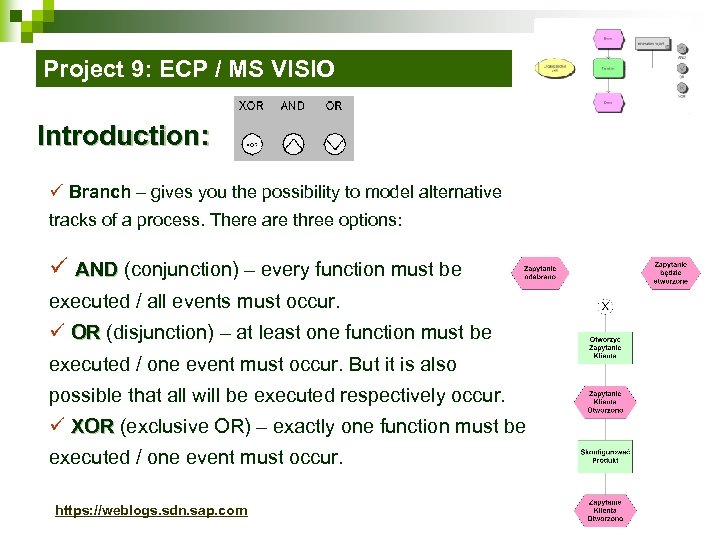
Project 9: ECP / MS VISIO Introduction: ü Branch – gives you the possibility to model alternative tracks of a process. There are three options: ü AND (conjunction) – every function must be executed / all events must occur. ü OR (disjunction) – at least one function must be executed / one event must occur. But it is also possible that all will be executed respectively occur. ü XOR (exclusive OR) – exactly one function must be executed / one event must occur. https: //weblogs. sdn. sap. com
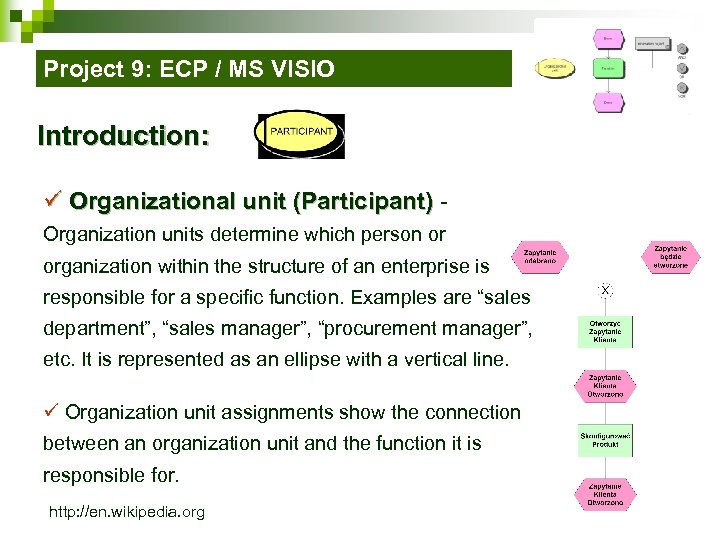
Project 9: ECP / MS VISIO Introduction: ü Organizational unit (Participant) Organization units determine which person or organization within the structure of an enterprise is responsible for a specific function. Examples are “sales department”, “sales manager”, “procurement manager”, etc. It is represented as an ellipse with a vertical line. ü Organization unit assignments show the connection between an organization unit and the function it is responsible for. http: //en. wikipedia. org
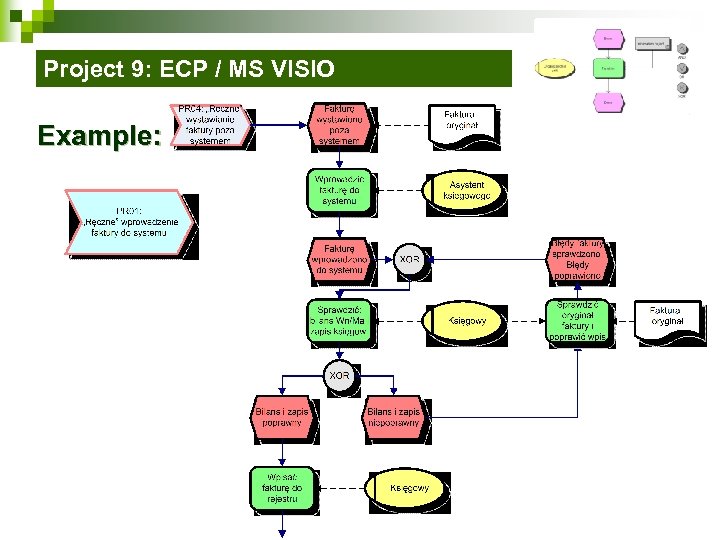
Project 9: ECP / MS VISIO Example:

Project 9: ECP / MS VISIO Diagram: „manua l” VISIO ARIS

9. Cash Flow analysis Methods and techniques of MBP

Cash Flow analysis: cash streams inflow start outflow t = time Cash at hand
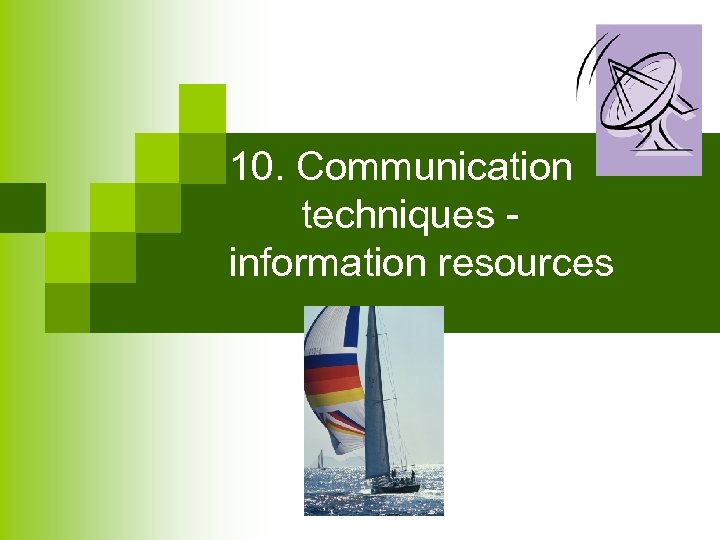
10. Communication techniques information resources

Communication techniques Principles of good communication: ü Communicate with yourself – before your try to understand others, you have to understand yourself! ü Put all important information in writing ü Make internal meetings regularly (once a week) ü Make sure to take advantege of the newest technology ü Value different opinions, ideas, thoughts ü Control your emotions – treat others right ü Listen to your business partners – take your time! ü Be open minded, look around – search for new ideas

Communication techniques A new model of organization:

Communication techniques Intelectual capital:

PROJECTS List – project management Project 1: Charts analysis – LOB Project 2: Gantt chart analysis Project 3: PERT Project 4: PERT – MS Visio Project 5: PERT – MS Project 6: BEP analysis Project 7: ISO – resources allocation Project 8: MS Project – resources allocation and control Project 9: ECP / MS VISIO Project 10: Cash Flow analysis Project 11: Communition techniques and principles
b9cb1fcbf7f1756abc478d9c5b23ea13.ppt